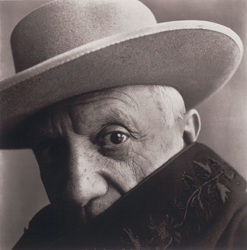In 1944, soon after starting his career at Vogue, Irving Penn arrived in Rome as a volunteer in the American Field Service, working together with the British Army as a photographer and ambulance driver. Penn noted:
Just arrived in Rome, intoxicated with Italy; a figure I saw coming down the Spanish Steps was de Chirico carrying a shopping bag of vegetables! I knew him instantly, without doubt. I rushed up and embraced him. He must have thought me crazy. To me he was the heroic de Chirico; to him I was a total stranger, probably demented. Still, he was moved and said come home and have lunch with us. For two days he showed me his Rome, and hungry for attention he posed and postured for my camera….1
These early experiments in photographing human subjects2 would prove fruitful once Penn returned to New York and to his employment at Condé Nast. There, in addition to fashion and still life work, Penn created photographic profiles of stars in music, dance, performance, art, and literature who were often featured in its "People Are Talking About" section. Just as Penn had sought a regular and repeatable frame for his prewar magazine work—a bank of movable tungsten lights to simulate daylight in any studio setting—now he developed a spare background to focus the image on the personality of the sitter and foreclose narrative readings of their pose.
Probably best known are his early "corner portraits." Penn recalled the simple device he hit upon:
Sometime in 1948 I began photographing portraits in a small corner space made of two studio flats pushed together, the floor covered with a piece of old carpeting. A very rich series of pictures resulted.
This confinement, surprisingly, seemed to comfort people, soothing them. The walls were a surface to lean on or push against. For me the picture possibilities were interesting; limiting the subjects' movement seemed to relieve me of part of the problem of holding on to them.3
In the 1950s, Penn shifted toward head-and-shoulder portraits, and then in the 1960s undertook still closer studies of the face. He always maintained a discreet background, however, often employing only a backdrop with little or no furniture. "The settings he chose," as art historian Magdalene Keaney has observed, "became increasingly neutral…. As a result there is a greater emphasis on a subtle exploration of gesture and expression between photographer and sitter."4 The lack of context confuses the viewer's sense of scale and heightens awareness not just of the sitter's face and what it reveals, but of what is unseen.
For example, Penn's portrait Picasso at La Californie, Cannes, France (1957) captures more than the man and the elaborate embroidery on the collar his bullfighter's cape. The tight cropping of Picasso's face and deep highlight and shadow across it flatten the image, mirroring the breakdown of the world into shapes Picasso brought about with Cubism. Ironically, that window onto the world that Cubism eventually shattered in painting is literally reflected in Picasso's left eye.5 It represents not only the world beyond the viewfinder and studio, but also the tool of the current artist at work—the natural, ideally northern, daylight in which Penn preferred to work.
Reflecting on his experiences in portraiture, Penn wrote of the variety of responses he generated among creative types in different fields:
I will I think at this point risk a few generalizations about photographing people in the arts—at one extreme I would put painters and sculptors least of all aware or concerned about their image as it will appear on the printed page; next I would put writers much more difficult, often suspicious of my intentions, sometimes surprisingly hostile, reassured only by the word, not at all aware of the plastic process. At the other pole I am afraid I must put musicians. I think that I can speak after many experiences through a number of years with only the rarest exceptions I am afraid that the perceptive genius of musicians has been limited to their music, and sitting with musicians have generally been barren experiences, often ending awkwardly, followed sometimes by rage and recriminations. I think there is something in the hothouse handling of musicians by the people in their world that makes them think of photographers as part of their public-relations apparatus, preparing them for appearance before their public, aides only in projecting their image of themselves.6
Penn continued to employ this narrative-resistant type of view in his portraits until his death. Across these slightly varied methods, as with his ethnographic projects—which are really subcategories of his portraiture—Penn aimed to capture people away from their daily lives. Ultimately, Penn was interested in something far deeper and richer than how his subjects looked: he sought the personality behind his or her public mask.
Archive Information
Series IX: Portraits in the Paper Archive consists of articles illustrated with Penn's portrait works, arranged chronologically by the year of the portrait sitting, and material gathered by the staff of the Art Institute of Chicago, including correspondence from living portrait subjects who were asked for reminiscences of their experience sitting for Irving Penn. See a list of portrait subjects.
Series V: Portrait Photography in the Photographic Archive consists of black-and-white negatives, test prints, and contact sheets in various sizes of portrait subjects.
1 Irving Penn. Passage: A Work Record. New York: Alfred A. Knopf, 1991, p. 18.
2 See Szarkowski, John. Irving Penn. New York: The Museum of Modern Art, 1984, p. 22 for additional photographs from this time period and discussion of their impact on his later work.
3 Passage, p. 50.
4 Keaney, Magdalene. Irving Penn Portraits. London: National Portrait Gallery, 2010, p. 7.
5 For more discussion of this portrait and eyes, see Mark Haworth-Booth introduction to Irving Penn Fringes, PaceWildensteinMacGill exhibition catalog, 1996, n.p.
6 Notebook A12 titled 'Irving Penn", n.d.,
(Box.FF 185.8).
Irving Penn. Picasso at La Californie, Cannes, France, 1957. Gift of Mrs. Leigh B. Block, 1977.908.

